Italian Psychoanalytical Society

Roberto Musella, Anna Migliozzi, Adriana Ramacciotti (Editorial Project)
Contributors: Sarantis Thanopulos (President of SPI), Rita Corsa, Franco De Masi, Alberto Luchetti, Paolo Chiari Giuseppe Riefolo
Translation: Maria Pina Colazzo, Full Member SPI
Introduction
(Contributor: Thanopulos Sarantis, President of SPI)
The SPI (Italian Psychoanalytical Society) is founded on a pluralism of voices and dialogue among them. It is a society of people with different scientific and cultural orientations, but without any opposition among them, equal as regards freedom of expression and the accomplishment of their theoretical and clinical research projects.
The SPI knows that the culture of psychoanalytic treatment is spread over an area which extends beyond its borders and it maintains open dialogue, respectful of differences, with the associations involved in this area. It recognises the importance of a constructive alliance, without ideological preclusions, of all the forces operating in the field of public mental health. This is why it is constructing the foundations to bring together all the parties involved in this field towards a common project of interpretation and treatment of suffering, capable of opposing the pressure of the bio-medical model which is taking over psychiatry. Combining “quantitative” work which acts on the economic aspect of pain, with the aim of relieving it, with “quality” work which acts in furthering its elaboration is the unifying goal towards which the SPI is working, fully aware of the fact that turning the legitimate conflict between different scientific points of view into unyielding opposition is damaging to those who are suffering.
The SPI is sensitive to all the areas of mental suffering that require adaptations of setting which can extend the reach of the application of the psychoanalytic method and dedicates a significant part of its clinical research activities to working with children, teenagers, groups, couples and families. It defends the rigour of psychoanalytic research, considering it inseparable from the originality of the contributions. It converses with tradition, the common indispensible heritage of all psychoanalysts, in creating new ideas.
The origin
(Contributor: Rita Corsa, SPI Traning Analyst and Full Member of SPI)
The Italian Psychoanalytical Society (S.P.I.) was founded at Teramo on 7 June 1925 by the psychiatrist Marco Levi Bianchini, director of the local mental hospital and among the first promoters of psychoanalysis in Italy.
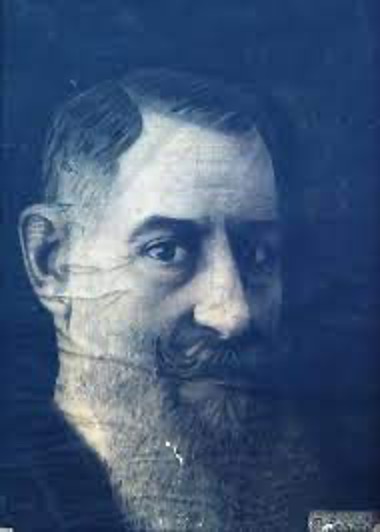 Marco Levi Bianchini (Rovigo, 1875 – Nocera Inferiore, 1961) was an eccentric psychiatrist who, like many scientists of his time, was a child of the fin de siècle positivist “epidemic”. He graduated with a psychiatric thesis that was Lombrosian in orientation and completed his training with Emil Kraepelin at Munich. At the same time, however, his unlimited faith in anatomical, physical and chemical empiricism - which then animated the medical class - began to falter, inducing him to transcend the rigidly biological dimension and to venture into the unexplored and revolutionary territory of psychoanalysis. The editorial dynamism of Marco Levi Bianchini bore fruit in the creation of the periodical Archivio Generale di Neurologia e Psichiatria (1920) (General Archive of Neurology and Psychiatry). In 1921 the journal changed into the Archivio Generale di Neurologia Psichiatria e Psicoanalisi (General Archive of Neurology, Psychiatry and Psychoanalysis), the first psychoanalytical review in Italy. From 1926 to 1931 the Archivio was consecrated as the official organ of the newborn Italian movement.
Marco Levi Bianchini (Rovigo, 1875 – Nocera Inferiore, 1961) was an eccentric psychiatrist who, like many scientists of his time, was a child of the fin de siècle positivist “epidemic”. He graduated with a psychiatric thesis that was Lombrosian in orientation and completed his training with Emil Kraepelin at Munich. At the same time, however, his unlimited faith in anatomical, physical and chemical empiricism - which then animated the medical class - began to falter, inducing him to transcend the rigidly biological dimension and to venture into the unexplored and revolutionary territory of psychoanalysis. The editorial dynamism of Marco Levi Bianchini bore fruit in the creation of the periodical Archivio Generale di Neurologia e Psichiatria (1920) (General Archive of Neurology and Psychiatry). In 1921 the journal changed into the Archivio Generale di Neurologia Psichiatria e Psicoanalisi (General Archive of Neurology, Psychiatry and Psychoanalysis), the first psychoanalytical review in Italy. From 1926 to 1931 the Archivio was consecrated as the official organ of the newborn Italian movement.
In 1925 twelve doctors attended the inauguration of S.P.I., most of them psychiatrists, among them Edoardo Weiss, the only one to have had a personal analysis (with Paul Federn) and been taught directly by Freud and the Viennese group. News of the Society’s foundation was greeted favourably by Freud. Edoardo Weiss (Trieste, 1889 – Chicago, 1970) was elected President, while Levi Bianchini was appointed Secretary. Endowed with few resources, located in a peripheral region, and composed of psychiatrists with little knowledge of psychoanalysis, the S.P.I. had a rather laboured existence and did not make an incisive impact on the culture of the time.
the only one to have had a personal analysis (with Paul Federn) and been taught directly by Freud and the Viennese group. News of the Society’s foundation was greeted favourably by Freud. Edoardo Weiss (Trieste, 1889 – Chicago, 1970) was elected President, while Levi Bianchini was appointed Secretary. Endowed with few resources, located in a peripheral region, and composed of psychiatrists with little knowledge of psychoanalysis, the S.P.I. had a rather laboured existence and did not make an incisive impact on the culture of the time.
Having suspended its activities in May 1928, the Society reassembled and relocated from Teramo to Rome on 1 October 1931 at Weiss’s house. On this occasion, requests for membership were accepted from Sante de Sanctis (Honorary President), Giovanni Dalma, Marco Levi Bianchini (Honorary President), Ferruccio Banissoni, Nicola Perrotti (Vice President), Emilio Servadio, Cesare Musatti, Ettore Rieti (Treasurer), Edoardo Weiss (President) and Vanda Weiss, the first woman to be a member of the S.P.I.
The new constitution, approved in 1931, required prospective members to undertake a training analysis with an experienced psychoanalyst and to draft a technical report which would demonstrate their knowledge of psychoanalytic principles. From 1932 to 1938, the year of its pre-war dissolution, the S.P.I. had Edoardo Weiss as President, Vice President Nicola Perrotti and Treasurer Ettore Rieti.
In 1932, with the reorganisation of the Psychoanalytic Society in Rome, was created the Rivista Italiana di Psicoanalisi [Italian Journal of Psychoanalysis], and this journal was adopted as the specific organ of the movement. Edoardo’s wife, Vanda Shrenger Weiss (Pakrac, 1892 – Berkeley, 1962) - doctor, paediatrician and psychoanalyst - played a crucial part in the Roman reconstruction of the Italian Psychoanalytical Society, whilst also being a founding member of the Rivista Italiana di Psicoanalisi.
In 1936, during the International Congress of Marienbad, the Italian Psychoanalytical Society was officiacially recognized and accepted by I.P.A.
Edoardo Weiss was the most important psychoanalyst of this first season of the S.P.I. Initially he was devoted to the spread of psychoanalysis, both publishing various papers in German, English and Italian Psychoanalytical journals, and translating several Freudian works into Italian. His most innovative theoretical writings concerned with agoraphobia, social phobia, psychosomatic deseases, Ego disorders in serious mental illnesses in the wake of Ego Psychology.
In the Thirties, the S.P.I. tried to stand firm against a growing opposition from the Catholic Church - which accused psychoanalysis of “immorality” and “pornography” - and from the Fascist regime, which was hostile to its diffusion as a doctrine developed in a foreign country, upheld by scientists of Jewish origin, and politically oriented towards the left. As early as 1934, the Rivista Italiana di Psicoanalisi was obliged to shut down because its publishing licence was not renewed. In 1938 the S.P.I. itself was wound up, with the official justification that it was affiliated to the I.P.A., which was suspected of undertaking clandestine political activities.
With the promulgation of the racial laws in 1938, the Italian group dispersed, seeking refuge abroad. The next year, Vanda and Edoardo Weiss, together with their two sons, emigrated permanently to the United States of America.
From the Second World War to the ’70s
[Contributor Anna Migliozzi, Full Member SPI: I wish to thank P. Chiari e Giuseppe Riefolo for the Chapter II, Dal dopoguerra agli anni 70, La Società Psicoanalitica Italiana, F. Castriota, Mimesis, 2020, Milano, for their permission in using their text in the elaboration and construction of this section.]
Shortly before the end of the Second World War, in 1944, J. Flescher, a Polish doctor and refugee from Galizia living in Rome, published the book Psychoanalysis of Instinctual Life, the first post-war book of psychoanalysis. He became a student of Weiss in 1945. Then, in 1946, Emilio Servadio returned from India. Consequently, in April 1947, the Società Psicoanalitica Italiana (SPI) was re-formed, with Nicola Perrotti as President, and the Rivista di Psicoanalisi (Journal of Psychoanalysis) (1945), directed by Flescher, became its official publication. Already in 1946, a few months after Servadio’s return from India, the first Congress had been held in Rome, with, among others, Perrotti, Servadio, Modigliani, Tomasi di Palma, and Flescher attending (Reichmann, 1997). However, in 1947, Flescher moved to the United States and so the Rivista was short-lived, lasting only two years.
1947, the Società Psicoanalitica Italiana (SPI) was re-formed, with Nicola Perrotti as President, and the Rivista di Psicoanalisi (Journal of Psychoanalysis) (1945), directed by Flescher, became its official publication. Already in 1946, a few months after Servadio’s return from India, the first Congress had been held in Rome, with, among others, Perrotti, Servadio, Modigliani, Tomasi di Palma, and Flescher attending (Reichmann, 1997). However, in 1947, Flescher moved to the United States and so the Rivista was short-lived, lasting only two years.  Subsequently, Perrotti (1948) promoted the creation of Psiche, “Journal of Psychoanalysis and Human Sciences”, with the aim of applying psychoanalysis to the great social themes of the period. However, the journal was only published until 1951.
Subsequently, Perrotti (1948) promoted the creation of Psiche, “Journal of Psychoanalysis and Human Sciences”, with the aim of applying psychoanalysis to the great social themes of the period. However, the journal was only published until 1951.
It is worth remembering that Perrotti, as well as becoming President of the SPI (1947-1951), was successful in the political elections of the newly-formed Republic of Italy in 1948. Thus the first President of the SPI was also a member of parliament.
In 1949, Cesare Musatti published the Trattato di psicoanalisi (Treatise on Psychoanalysis) and the following year, 1950, the Second National Congress of the SPI was held on the theme of Aggression.
Congress of the SPI was held on the theme of Aggression.
It was, however, not until 1976 that the third Congress was held in Venice, following deep conflicts between the branches in Rome and Milan.
From 1951, the new President of the SPI was Musatti and from 1955, the Rivista di Psicoanalisi was once more published as the official organ of the SPI, of a scientific nature.
The years from 1950 to 1970 were a period of apparent suspension during which the SPI had to come to terms with social, political and cultural issues and internal conflict, from which it emerged as a more structured organisation.
The period concluded with the approval of the “statuto Corrao” (1975), a reform which ratified the establishment of common regulations.
Already by 1955, the foundation of the Rivista di Psicoanalisi had revealed a more important disagreement, that of training new psychoanalysts. Servadio believed that the Society should grow slowly, subjecting its pupils and young members to stringent tests of their abilities and theoretical understanding; Musatti, by contrast, while recognising that not even the founders had undergone such a process and considering training to be necessary, thought that the younger members could begin to treat patients, and some of his pupils were already working autonomously, under his supervision.
The conflict over training flared up during the Edinburgh International Congress in 1961, when the Board of the International Psychoanalytic Association (IPA) decided to place the SPI under the control of a special Commission as a result of the serious disarray into which the Italian Society had fallen. Enacted in 1961 under the direct intervention of the IPA, the reform was still unable to resolve the problems of power within the SPI, due above all to the differences regarding training which “made the criteria for training analysts in the Society non-standardised. Furthermore, the interests of the individual institutions did not always coincide with those of the Society as a whole” (Gaddini, 1971, 260).
On the 6th of May 1968, for the IPA celebration, the SPI was represented by the president, Musatti, his predecessor, Perrotti, and Servadio. Also present were Egon Molinari, Scarizza, Adda Corti and Lyda Zaccaria Gairinger. At that time (1970), Italy began to request psychoanalytic treatment, also for non-neurotic pathologies, leading to a renewal of theory and technique. Meetings with foreign Societies, such as those from France and Great Britain, helped this renewal.
Despite the boom in requests for analytical treatment, the number of SPI analysts remained substantially the same. This was largely due to the defensive position adapted by an institution that was still in its infancy and culturally external to – if not actually opposed by – the official mainstream.
Slowly, however, psychoanalysis caught on with the public at large and the cultural world. The film Diary of a Schizophrenic Girl came out in 1968, directed by Nelo Risi, with Franco Fornari as consultant, adapted from the book by the Genevan psychoanalyst M. Sechehaye (1950), published in Italy with an introduction by Musatti. The Basaglia Reform for Mental Health also allowed psychoanalysis to gain greater favour in cultural and political spheres. Even the Church accepted the validity of psychoanalysis (1970, although officially in 1975) and agreed to support the compatibility, if not complete convergence, of psychoanalysis with the Catholic religion. The opening of the Catholic Church to psychoanalysis happened at the same time as widespread movements throughout Europe, where psychoanalysis gradually gained fully-fledged rights within Catholic culture (Cimino, Foschi, 2018). Father Gemelli and Musatti, one in Milan and the other in Padua, promoted the introduction of Psychology into universities, leading to the establishment of chairs of Psychology in the schools of Medicine, then the arrival (1971) of the first two faculties of Psychology in Italy, with inaugurations in Rome and Padua. Within these movements, Psychoanalysis in Italy, and the SPI in particular, were a reference for psychiatry.
While it is true that there were no National Congresses, there were, however, the “Scientific Meetings” in Rome and international events, such as the XXV Congress of Romance Language Psychoanalysts (Milan, 1964), whose acts were regularly published in the Rivista di Psicoanalisi, an indication of a growing movement.
The 1965 scientific meeting and the 1968 Conference in honour of Edoardo Weiss for the 50th anniversary of the liberation of Trieste were indicative of the generational change from the pioneers to the new conscripts, as well as of the inroads made into Humanities, literary culture and cinema. Michel David was present and among the speakers were Sergio Bordi, Carlo Traversa, Eugenio Gaddini, Novelletto, Francesco Corrao and Franco Fornari, as well as Tagliacozzo, Sigurtà and Bellanova.
For the 1976 SPI Congress in Venice, there were 108 members, 43 of them ordinary and more than 100 candidates. In those years, “requests to institutions for admission as candidates in training were far in excess of the possible placements within the institutions themselves” (Gaddini, 1971, 262). The SPI accepted up to 20% non-doctors. Step by step, there emerged “the clear gradual development of a process of integration and a concurrent move towards a unitarian identity of the Society, in contrast to the original segmented situation and fragmented identity” (Gaddini,1980, 463). In 1982, there were 85 ordinary and 125 associate members, and 204 candidates. A quarter were not doctors, while 148 were women and 266 men: “over the last decade, members have doubled” ( Bellanova, 1982,110). In 1988, there were 225 members and 233 candidates. The SPI was fourth in scale in Europe behind Germany, France and Great Britain.
The reform by Corrao, president from 1969 to 1974, defined the new organisation in line with IPA rules. The new statute was approved on the 3rd of February1974 by a board consisting of Fornari, Gaddini, Tagliacozzo, Bellanova and Carloni.
This statute approved the distinction between the powers for training new analysts, which was maintained by the Institutions, and the cultural movement, which was granted to new Centres. This move, apparently inspired by motives of “power”, guaranteed the continuing existence of the group and was separate from the powers of the association. With the creation of the Centres, the SPI in Italy gained a clear increase both at the level of cultural visibility and as regards new membership. Furthermore, the creation of these Centres, autonomous from the Institutions, provided the means to overcome geographic obstacles and invigorate the scientific life of the Society, favouring the setting up of local research groups, physical opportunities for regular meetings, exchange of ideas and open discussion.
The conflicts in Italy always concerned internal power regarding the training of new analysts in relation to the charismatic figures of the founders. For example, in 1992, a group of analysts in Italy, who had a good relationship with Joseph Sandler, at that time president of the IPA, also with the support of Servadio, set up a second society affiliated to the IPA, AIPsi. In this case as well, motives of an ethical nature were intertwined with motives regarding power over the nomination of teachers, and therefore the possibility of new rules for the organisation and running of psychoanalytic training.
One particular aspect of the SPI is that it has always maintained, even if with alternating fortunes, a relationship with Psychiatry. In 1976, the specific interest of psychoanalysis in social problems and psychiatric institutions started a dialogue which was presented at the 1976 Congress, entitled “Psychic reality, the internal world and the external world”. From that moment, Italian Psychoanalysis would orient its theoretical concerns towards a cultural comparison with the international psychoanalytic world while suspending the dialogue with psychiatric institutions which had developed in the preceding years. The protest movements, also including young analysts, which led to the expulsion of some of them, resulted in psychoanalysis remaining substantially outside of the public and social institutional spheres. Some of these analysts found themselves excluded from the psychoanalytic movement, while others continued their aim of greater social involvement of the SPI, but largely on a personal level without managing even slightly to involve the institutions. Novelletto (1989) recognised that there had even been a decline in the initial drive for recognition of the specificity which animated the ‘69 protests: “in the twenty years which have passed since then, Italy has continued to be a destination for the scientific and teaching importation of psychoanalysts from British, French and American schools”.
The ’80s
(Contributor: De Masi F, Full Member of SPI)
The Eighties were the period in which the SPI shed its exclusive relationship with Francophone psychoanalysis and came into contact with the clinical practice and analytical theories developed in Great Britain by the Kleinian group. There were two reasons for this change. The first is that in those years the Kleinian group had produced, and continued to produce, notable development in clinical practice and analytical theories. The most prolific authors were Hanna Segal, Herbert Rosenfeld, Wilfred Bion, Donald Meltzer, Eric Brenman, Betty Joseph and others. The second reason was that it was a period of great generational change, so a large number of young analysts had joined the SPI and were thirsty for knowledge of clinical practice.
In that period, the Italian Society, even while counting great intellectual minds among its numbers, was suffering from an intrinsic weakness in clinical practice. Our pioneers, such as Musatti, Perrotti and Servadio, were high-level intellectual figures, involved in the post-war cultural renovation. They considered psychoanalysis to be a discipline destined to enrich Italian cultural heritage, so impoverished by the long Fascist provincial closure.
Yet Italian psychoanalysis was practically absent at an international level. It was not, or at best only marginally, present at international congresses, not only for linguistic reasons, but above all because it lacked genuine clinical knowledge.
It all began in a natural manner. Brenman was invited to Milan, then the choice was widened to include Rosenfeld, Meltzer, Harris and Pick. Betty Joseph was regularly invited to Turin, while Hanna Segal came to Rome. Bion himself held an important seminar in Rome.
It went on this way, creating a group of colleagues in contact with each other, a network running through all the most important centres; the Milanese came to Rome and Roman or Florentine colleagues went to Milan when necessary to take part in seminars with British colleagues. This period of learning and dialogue laid the foundations for the individual and collective creative growth of Italian psychoanalysis.
The result was that, while for years psychoanalytic thought had been imported from abroad, it was now Italian psychoanalysis exporting ideas and methods of working with patients. There is no doubt that the encounter with British Kleinian psychoanalysis was important and educational for many.
La Rivista di Psicoanalisi (Journal of Psychoanalysis )
(Contributor: Luchetti A., Training Analyst and Full Member SPI)
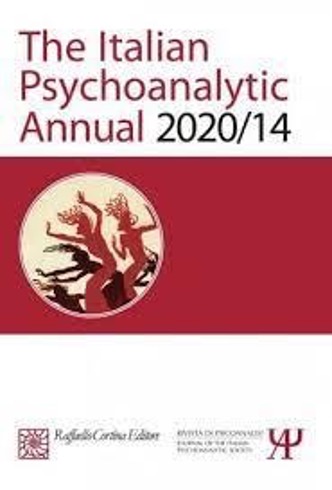 The Rivista di Psicoanalisi is the quarterly publication of the SPI, affiliated to the IPA.
The Rivista di Psicoanalisi is the quarterly publication of the SPI, affiliated to the IPA.
In 1932, Edoardo Weiss, a psychoanalyst from Trieste, founded and edited the Rivista Italiana di Psicoanalisi in Rome, the bimonthly «official
 publication of the Italian Psychoanalytic Society», created in 1925. The journal was short-lived, being closed down two years later by the Fascist authorities under pressure from the ecclesiastic hierarchy, after fourteen issues (the last two of which could not even be distributed).
publication of the Italian Psychoanalytic Society», created in 1925. The journal was short-lived, being closed down two years later by the Fascist authorities under pressure from the ecclesiastic hierarchy, after fourteen issues (the last two of which could not even be distributed).
In 1954, eight years after the reconstitution of the SPI after the Second World War, the Rivista di Psicoanalisi was founded in Milan, and the following year began to be published every four months under the editorship of Cesare L. Musatti, who had promoted the revival, from 1955 to 1971.
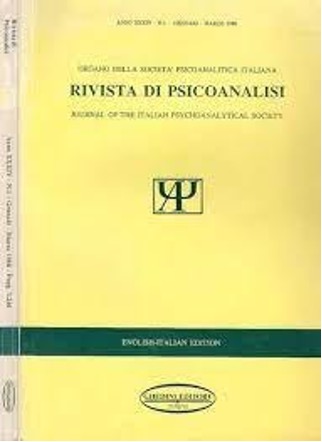 The co-editors were Nicola Perrotti, Emilio Servadio (replaced in 1962 by Pietro Veltri) and Alessandra Tomasi di Palma, with an office in Milan, first at the Institute of Psychology at the University of Milan (whose director was Musatti), then at the Milan Institute of Psychoanalysis. Initially featuring a sky-blue cover, in 1965 it changed to a yellow one for the following nearly thirty years.
The co-editors were Nicola Perrotti, Emilio Servadio (replaced in 1962 by Pietro Veltri) and Alessandra Tomasi di Palma, with an office in Milan, first at the Institute of Psychology at the University of Milan (whose director was Musatti), then at the Milan Institute of Psychoanalysis. Initially featuring a sky-blue cover, in 1965 it changed to a yellow one for the following nearly thirty years.
From 1971, after this “pioneering” phase, there began a new “institutional” phase, in which it was edited by the SPI presidents, starting with Francesco Corrao (1972-1973) with the participation of the whole board, assisted by an editorial committee. With Franco Fornari (1974-1978), the head office was moved to Rome and publication was entrusted to the publishing house Il Pensiero Scientifico (Rome). In 1981, under Eugenio Gaddini (1978-1982), the journal went from being four-monthly to quarterly, the head office was moved to Rome and publication was entrusted to the publishing house Il Pensiero Scientifico. As editors there followed Glauco Carloni (1982-1986) and Giovanni Hautmann (1987-1990), under whom from 1988 it was published in a bilingual edition, Italian-English, which continued under Roberto Tagliacozzo (1990-1992), while with the change of publishers (Ghedini in Milan, then Borla in Rome), the head office was once again moved to Milan.
In 1993, first under Giuseppe Di Chiara (1993-1994) and then Antonio Alberto Semi (1994-1996), there began the so-called “phase of directional and scientific autonomy”, marked by a new dark red cover, a new editorial team chosen by the editor, once more in Rome, and a rigorous method of evaluation of articles by peer review. In fact, the new Statute of the SPI created the role of Editor of the Rivista di Psicoanalisi, separate from that of the President of the Society, and elected by the Assembly of Members and the Board of the SPI. While still the Society’s official publication, the journal acquired complete editorial autonomy, which has continued to the present day. The successive editors were Pier Luigi Rossi (1997-2002), Agostino Racalbuto (2003-2005), Patrizio Campanile (2005-2009), Alberto Luchetti (2009-2013), Giuseppe Civitarese (2013-2017), and Paola Marion (2017-2021). The current editor is Alfredo Lombardozzi.
Psiche
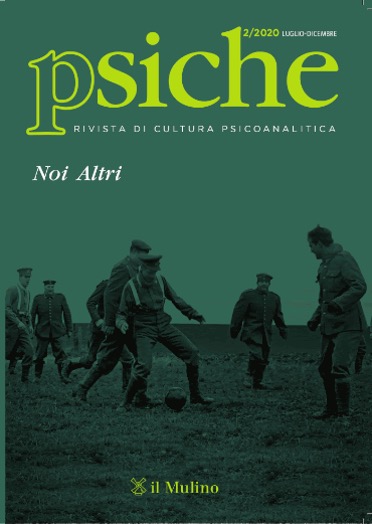 Psiche is an SPI journal which has become part of contemporary cultural debate through the voices of psychoanalysts and academics from various disciplines. Founded by Nicola Perrotti in 1948, it distinguished itself from the start by its attention to the psychological aspects of social life, establishing itself as a precious instrument in the analysis of the present age and its transformations. Aimed at a wide public of cultured readers, attentive to university students, psychologists and clinicians in training and open to interdisciplinary dialogue, it has a Scientific Committee and a mixed editorial board: psychoanalysts, scientists, anthropologists, philosophers, historians and literati. Publishing two monographs a year, it is currently edited by Stefania Nicasi.
Psiche is an SPI journal which has become part of contemporary cultural debate through the voices of psychoanalysts and academics from various disciplines. Founded by Nicola Perrotti in 1948, it distinguished itself from the start by its attention to the psychological aspects of social life, establishing itself as a precious instrument in the analysis of the present age and its transformations. Aimed at a wide public of cultured readers, attentive to university students, psychologists and clinicians in training and open to interdisciplinary dialogue, it has a Scientific Committee and a mixed editorial board: psychoanalysts, scientists, anthropologists, philosophers, historians and literati. Publishing two monographs a year, it is currently edited by Stefania Nicasi.
The SPI and its Centres
The SPI is part of the IPA and the European Federation of Psychoanalysis (EFP).
SPI psychoanalysts are surgeons, psychiatrists, child neuropsychiatrists, psychologists and psychotherapists. It also has a training school, the National Institute of Training. It is involved in training analysts in personal analyses, with a four-year theoretical-clinical course and the supervision of clinical cases with a recognised experienced analyst. Over the whole course of their professional lives, SPI analysts then follow a continuous activity of clinical and theoretical debate, guaranteeing the progression of their analytical ability.
The SPI currently has 947 members and 282 candidates and is spread over 13 Psychoanalysis Centres in Bologna, Florence, Genoa, Messina, Milan, Naples, Padua, Rimini, Rome (2 Centres), Palermo, Pavia and Turin. Each Centre has a consultation service. Consultation is an important moment of contact with one’s own difficulties, which are shared with a psychoanalyst in one or more meetings.
These Centres have numerous aims: above all, offering disadvantaged people the opportunity of low-cost access to psychoanalysis or psychoanalysis-oriented psychotherapy; fostering and spreading awareness of the psychoanalytic approach over a very wide social context; allowing members and candidates, should they so wish, to carry out clinical activity in the centres; promoting clinical research at various levels; encouraging work, exchange and study, thanks to the context of group work.
The Centres are available to adults of every age, children, teenagers, parents, couples and families who suffer mental anxiety. They are also open to doctors, psychologists, educators, teachers, paediatricians, nursing orderlies and guidance counsellors with specific professional difficulties.
Psychoanalytic Listening Service in the coronavirus emergency
The SPI has made available 400 psychoanalysts – doctors and psychologists – who have so far answered about 1,300 requests for a total of nearly 4,000 interactions. This service is also part of a wider initiative coordinated by the Health Ministry together with other psychotherapy associations, tackling the psychological emergency through first and second level interactions, coordinated by the Ministry at a national level. The service has been helped by a wide IT network (Spiweb and social media) and publications (books, articles).
The PER Group (European Psychoanalysts for Refugees)
The PER was set up in the early months of 2016 when, within the SPI, in collaboration with the wider working European Group of the European Federation of Psychoanalysis, the proposal was made to create forms of clinical assistance and psychoanalytic training to offer support in the worsening European refugee emergency, with the intention of developing a common conscience in contrast to the “grey area of indifference” (Primo Levi, “The Drowned and the Saved”).
Geographies of Psychoanalysis
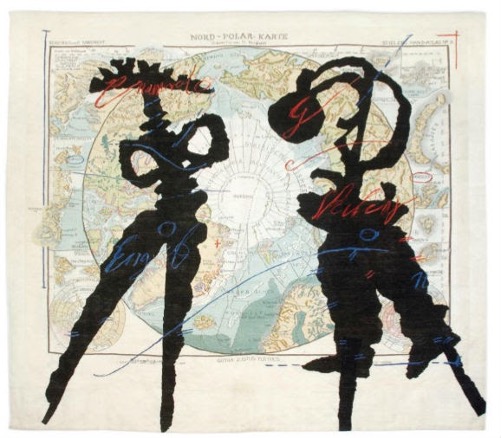 The project works to promote study and research related to the development and "contamination" of psychoanalysis which is living and evolving outside the current boundaries of where it is dispersed
The project works to promote study and research related to the development and "contamination" of psychoanalysis which is living and evolving outside the current boundaries of where it is dispersed
The Psychoanalysis and Justice Group
The contribution of psychoanalysis in the diverse, complex legal field, through the experience and expertise of SPI colleagues, part of the newly-established Psychoanalysis and Justice commission.
The SPI collaborates with various institutions, museum networks, modern art galleries, cultural centres and film festivals.